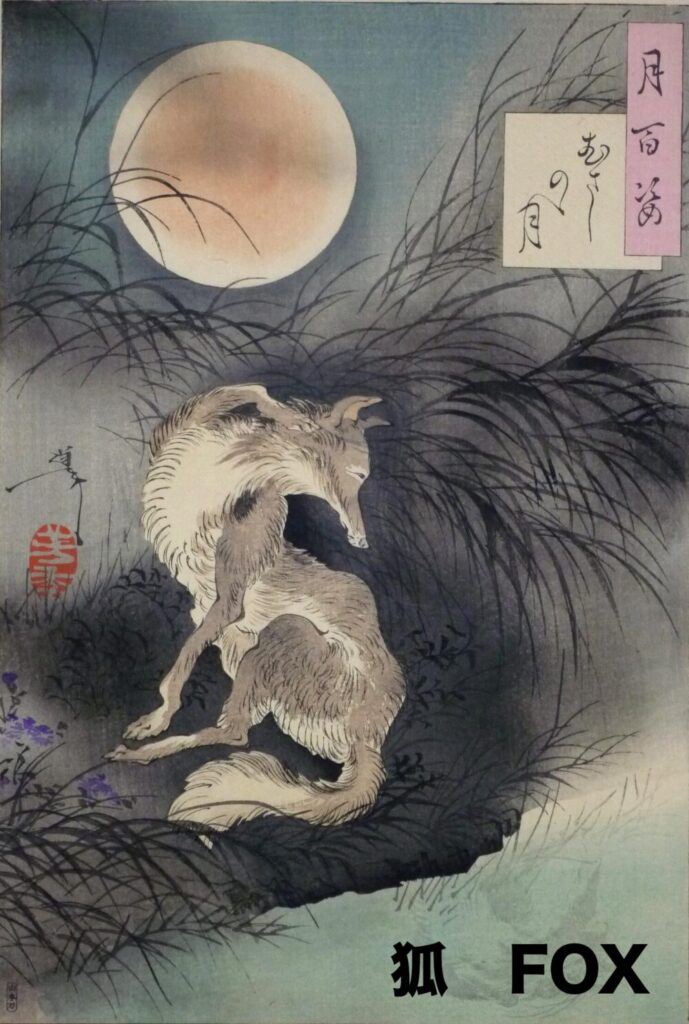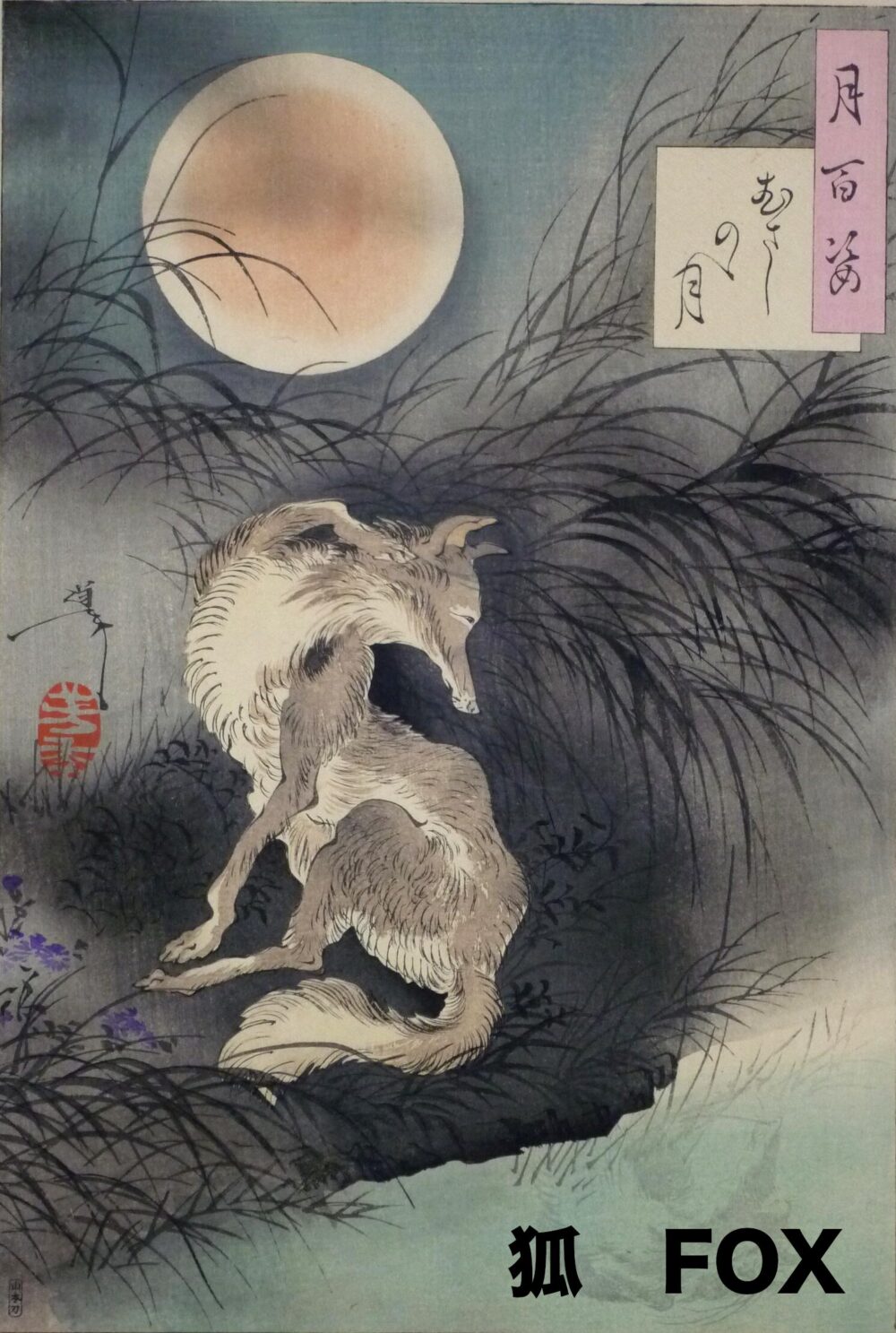Foxes are also known for their ability to deceive humans. In particular, they are famous for their skill in “transforming into humans.” Sometimes, they even disguise themselves as people close to their target, tricking them so thoroughly that the person never realizes they were deceived by a fox. Notable examples include the Nine-Tailed Fox and Tamamo-no-Mae. In Japanese.

The Foxes and The Raccoon Dogs
When it comes to animals that deceive humans, raccoon dogs (tanuki) are as famous as foxes. So, which of the two holds a higher rank? While there are various theories, foxes seem to be regarded as more sacred beings.
Fox and Deity
As evidence that foxes are considered superior to raccoon dogs, there is the belief that “foxes are messengers of the gods.” They appear in folk beliefs and Japanese mythology as the divine servants of Inari, the deity of bountiful harvests, and Ukanomitama. In fact, at Fushimi Inari Shrine in Kyoto, thousands of red torii gates have been dedicated to pray for prosperity in business, as the shrine is devoted to the worship of Inari.
Inari Worship is the Veneration of Multiple Deities
Inari worship encompasses the characteristics of multiple deities.
- Ukanomitama: The deity of grains and food.
- Omiyanome: A goddess enshrined at Inari shrines, responsible for ritual and ceremonies.
- Sarutahiko: A deity who guides travelers and protects traffic safety.
These are some of the representative examples.
Inari deity and Ukanomitama
Inari deity and Ukanomitama are often regarded as the same entity, but it is clear that they are fundamentally different deities. Here is a table illustrating their differences.
| Aspect | Inari Deity | Ukanomitama |
| Origin | Developed in the context of Inari worship. | Japanese mythology (such as in the Kojiki and others). |
| Character | A being that fusions multiple divine forms. | A deity of agriculture, overseeing grains and rice cultivation. |
| Role | Abundance of the five grains, prosperity in business, safety and well-being of the household. | Guardian of the production and harvest of all food. |
| Worship | Foxes and Inari shrines as divine beings. | Mainly enshrined as the deity of the shrine. |
It seems that there is strong popular faith in both, with a notable characteristic being their strong connection to agriculture and the abundance of the five grains.
There are several shrines where Ukanomitama is clearly enshrined as the Inari deity. Of course, foxes are also referred to as “O-inari-sama” (the revered Inari).
- Fushimi Inari Taisha (Kyoto)
This is the head shrine of Inari worship, with Ukanomitama as the main deity. - Kasama Inari Shrine (Ibaraki Prefecture)
A historic shrine built in 651 AD, where Ukanomitama is enshrined.
Other famous Inari shrines, such as Toyokawa Inari, are sometimes considered, but their main deity is Dakini-ten which is different.
Examples of Being Deceived by a Fox
Foxes are also divine servants endowed with sanctity. However, they still often deceive humans. Below, I would like to excerpt a few passages from Yanagida Kunio’s Tono Monogatari .
Sixty
In the village of Wano, there was an old man named Kabe, who entered a pheasant coop to wait for pheasants. However, foxes would frequently appear and chase the pheasants away. One time, frustrated by their mischief, he thought to shoot the fox, aiming carefully. But as he did, the fox turned toward him, giving a completely indifferent expression. When he pulled the trigger, the gun misfired. Uneasy, he checked the rifle and found that, unbeknownst to him, the barrel had been completely packed with dirt up to the muzzle.
Ninety Four
This story features Kikuzo, who went to visit his sister’s house in Kashiwazaki and, after being served some leftover rice cakes, tucked them into his pocket. As he passed through a forest at the foot of Mount Atago, he ran into a friend named Fujishichi, a notorious heavy drinker, who was in good spirits and invited Kikuzo to wrestle with him in a grassy area in the woods. The two of them began to wrestle, and although Kikuzo easily threw Fujishichi, they continued for three rounds, enjoying themselves.
After the third round, Fujishichi, seemingly exhausted, said that he couldn’t continue and suggested they part ways. Kikuzo walked away for a few paces, but then he realized that the rice cakes in his pocket were gone. He returned to the wrestling spot and searched but couldn’t find them. He briefly suspected it might have been a fox’s trick, but he was too embarrassed to mention it to anyone at the time.
Several days later, Kikuzo met Fujishichi at a tavern, and when the topic of wrestling came up, Fujishichi casually mentioned that he hadn’t been wrestling at all that day and had actually gone to the beach instead. It was then that Kikuzo realized he had wrestled with a fox, not Fujishichi. However, Kikuzo kept this incident hidden from others. It wasn’t until the following New Year’s holiday, when people were drinking and telling stories about foxes, that he admitted his own experience, to the great amusement of those around him.
One Hundred One
A traveler, passing through the village of Toyomane, grew tired as night fell. He was fortunate to spot the light of a familiar house and decided to rest there. Upon entering, he was informed that there had been a death that evening and that no one was home, so they were unsure what to do. Although it was an awkward situation, the traveler agreed to wait. The house’s owner went out to call for help, leaving the traveler by the hearth, smoking a pipe.
The deceased was an old woman, who had been placed in a room at the back of the house to lie down. As the traveler glanced over, he noticed something strange—suddenly, the figure on the bed began to stir and rise. His heart nearly stopped in fear, but he composed himself and quietly surveyed the room. He noticed something resembling a fox peering in through a hole near the water trough, its face fixed on the old woman’s body.
Realizing the truth, the traveler quietly hid and slipped outside, circling to the back of the house. There, he saw a fox, with its head in the hole and its back legs curled up in a stance like a fox. He grabbed a nearby stick and struck the fox, killing it.
In this way, even within the Tono Monogatari as told by Sasaki Kizen, three stories appear. Among them, story number 101 is particularly eerie, clearly showing that the fox was also skilled in sorcery.
Historically Renowned Mythical Foxes.
Unlike ordinary foxes that simply deceive people, there are foxes known as “mythical foxes” that possess extraordinary powers. I would like to introduce one such example.
The Nine-Tailed Fox
The Nine-Tailed Fox is the most feared fox in Japanese yokai folklore. It is depicted as a powerful creature with nine tails, possessing immense strength.
The legend of the Nine-Tailed Fox is said to have occurred during the reign of Emperor Toba (1103–1156) in the Heian period. The fox is famous for captivating those around it, even causing Emperor Toba to fall mysteriously ill. Eventually, the fox’s true identity was revealed by an onmyoji (a practitioner of Japanese occult arts), and it was ultimately slain at the Sesshoseki (Killing Stone) in the Nasu region.
Kuzunoha
Kuzunoha is a fox who fell in love with a human and lived among humans.
One of the most famous legends surrounding Kuzunoha is that she is said to be the mother of the legendary onmyoji Abe no Seimei. According to the story, Kuzunoha fell in love with a human man and had a child, but her true identity as a fox was eventually discovered. Heartbroken, Kuzunoha was forced to return to the mountains, and this tale of tragic love has been passed down.
In contrast to the Nine-Tailed Fox, this story gives a sense of warmth and familiarity, depicting a more humanized and poignant narrative.
The Shinoda Fox
This is a legend passed down in the Shinoda area of Izumi City, Osaka Prefecture, and at times, it is associated with Kuzunoha.
The story goes that Abe no Yasunari, a hunter, visited Shinoda Forest and came to the aid of a woman who was about to be attacked by a fox. This woman was actually a fox in disguise, and Yasunari fell in love with her. They had a child and lived happily together, but eventually, her true identity was revealed. Pursued by the villagers, she could no longer maintain her human form and returned to Shinoda Forest.
The theme of the crossing between humans and the otherworld is a poignant one, and it is an important motif in folklore and mythology.
Daji
Daji is a legendary figure known as a wicked woman from the Shang Dynasty in China, and she is said to have been a Nine-Tailed Fox in disguise.
Daji was the concubine of King Zhou (around 1100 BCE), the last ruler of the Shang Dynasty. Using her beauty and sorcery, she corrupted King Zhou, encouraging him to commit acts of torture and tyranny, which ultimately led to the downfall of the Shang Dynasty. After the fall of the Shang, it is believed that she traveled to Japan.
She is often regarded as the archetype of a beautiful but dangerous woman, embodying the role of the femme fatale who brings ruin to nations.
Byakumen Kinnmo Kyubi no Kitsune
The Nine-Tailed Fox, as it is described in Japan and China, is considered to be the prototype of the myth.
In India (though it’s unclear what role it played there), in China, it is associated with Dakki, and in Japan, it is known as Tamamo-no-Mae, a mythical fox that infiltrated the heart of the country and caused mischief and harm.
However, originally, the Nine-Tailed Fox was seen as a lucky creature with nine tails. In Feng Shui, the number 9 is considered the maximum value, symbolizing good fortune, longevity, and prosperity.
Summary
Foxes, like raccoon dogs, are known for deceiving people. However, it seems that foxes are often regarded as superior to raccoon dogs. One reason for this may be that foxes are seen as divine beings, being followers of the deity Uka-no-Mitama, which gives them a certain spiritual stature. Additionally, the ambiguity of their moral alignment adds to their allure.
While they are said to be auspicious creatures, they also possess the power to single-handedly destroy nations, demonstrating an interesting duality. This combination of traits—being both a bringer of fortune and a force of destruction—adds to the fascination surrounding foxes in mythology.



コメント